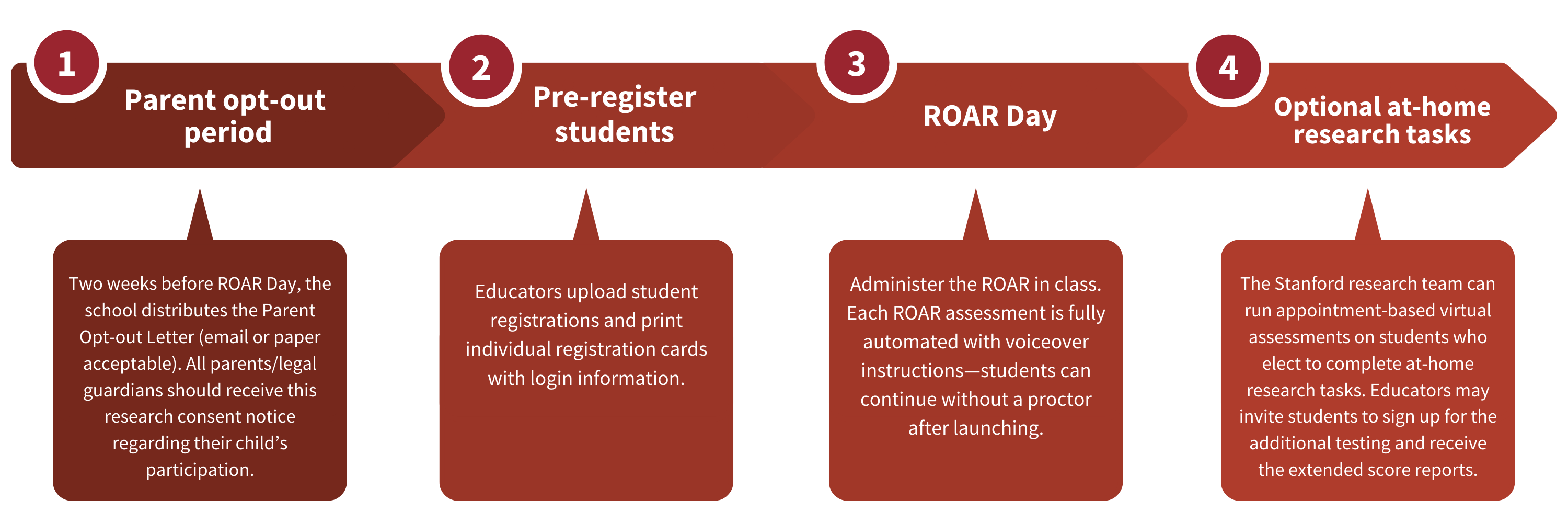For Educators
ROAR-Word
ROAR-Word measures a student’s ability to quickly recognize words. Word recognition is at the foundation of reading ability and is important for reading fluency and comprehension.
ROAR-Phoneme
ROAR-Phoneme measures elision and sound matching to assess a student’s phonological awareness.
ROAR-Sentence
ROAR-Sentence measures students’ ability to silently read and understand sentences quickly and accurately.
ROAR-Letter

ROAR-Letter measures knowledge of upper and lowercase letter names as well as letter sounds.

Are you interested in piloting the ROAR in your school or district? Check out our ROAR Partnerships Summary and fill out our ROAR Partner Interest Form!
Administering ROAR
Timeline for In-Class Administration

On ROAR Day, every student will need:
-
A Chromebook or laptop
-
Chrome or Firefox browser & wifi
-
Headphones
-
Registration Card
Budgeting time for the ROAR
- Single-Word Recognition (Word) requires 5-10 minutes.
- Phonemic Awareness (Phoneme) requires 10-15 minutes.
- Sentence Reading Efficiency (Sentence) requires 3 minutes.
- Comprehension Measures (Written Vocab, Picture Vocab, Morphology, Syntax and Inference) require 5 minutes.
- Consider budgeting extra time for Grades 1-2.
Administration Guide & Score Reports
ROAR Professional Development/Educator Resources
ROAR Professional Development Protocol — This document can be self-guided or completed as a group and provides a step-by-step method to reviewing the resources provided below
ROAR Executive Summary — High level overview of ROAR, how it’s used, and the administration process
Teacher’s Administration Guide — In depth guide to administering ROAR assessments
Guidance for Students Receiving Special Education Services and 504 Accommodations — Guidance on administering ROAR to students who receive special education and 504 accommodations
Quick-Start Guide for Paraprofessionals and Classroom Assistants — Guidance for paraprofessionals/classroom assistants on how to assist with administering ROAR
Guidance for English Language Learners — Guidance on administering ROAR to students who are English language learners
Next Steps Guide — Information about our four key assessments, the literacy skills that they assess, and ways in which educators can support these skills
Family Guide — An overview or ROAR assessments for students’ families to gain context and understanding as well as resources on ways they can support literacy skills at home
An Educator’s Guide to Strategic Decision-Making for Students who Need Extra Support — A structured method for making informed decisions about next steps for students needing extra support with foundational reading skills. This guide emphasizes the importance of thoughtful consideration at the individual and group levels within a classroom and systemically across a district.
Resources for Parents and Teachers — Where we link information on reading and dyslexia such as articles, books, websites, programs, and curriculums designed to support literacy
ROAR California Reading Difficulties Risk Screener Overview — Overview for organizations looking to utilize ROAR to fulfill the requirements put forward by recent California legislation
Video Guides
Introduction to ROAR — An overview everything you need to know about how ROAR works
ROAR in Schools — A look at how ROAR is being used in schools
ROAR: Breaking Barriers for Older Struggling Readers — How ROAR addresses barriers for older struggling readers
Guide to the Student Dashboard — An overview of a student’s view when logging into ROAR and starting assessments
Guide to Logging In to Your Educator Account — Steps to log in to ROAR as an educator or administrator
Guide to the Group Score Report — How to navigate and interpret score reports from a classroom, grade, or district level
Guide to the Individual Score Report — How to navigate and interpret a single student’s score report

If your organization is interested in a collaborative research partnership, please fill out our ROAR Partner Interest Form or email our Director of Research & Partnerships, Carrie Townley-Flores. (ctflores@stanford.edu)